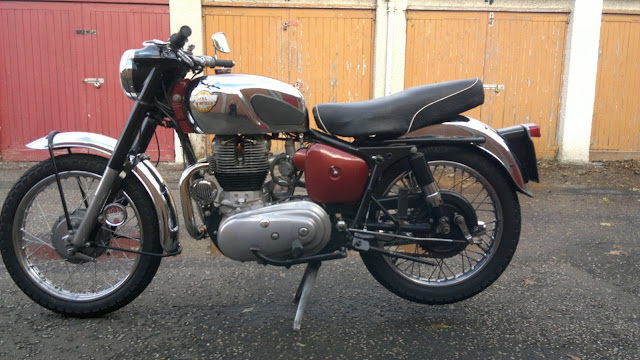Royal Enfield Constellation
Low handlebars and a big Smiths speedometer, calibrated to ISOmph (241 km/h), emphasized the Constellation’s sporty nature.
The Constellation's large chromed fuel tank and heavily finned engine gave a muscular look that was backed-up by the Enfield's storming straight-line performance.
If Royal Enfield could have endowed its Constellation with the reliability to match its performance, the result would have been a formidable machine. The 692cc parallel twin was one of the fastest bikes on the road following its launch in 1958. In that year one Constellation was clocked at 116mph (187km/h), giving it an edge over rival firms’ twins, and a magazine tester recorded an equally impressive two-way average of 112mph (180km/h).
Very few bikes on the road could live with the Constellation on acceleration from a standing start either, and the big motor also had plenty of low-down torque. But Royal Enfield's hopes that the Constellation’s straight-line speed would result in big sales came to nothing, largely because when ridden hard the big twin too often proved unreliable. Its list of problems included conrod failure at high revs, a slipping clutch and oil leaks.
The Constellation’s problems were highlighted by Enfield's experiences in long-distance production racing. Factory ace Bob McIntyre led the prestigious Thruxton 500-mile (805km) race four years in a row but had trouble each time. He managed a third place in 1958, despite losing timeROYAL ENFIELD CONSTELLATIONwith a split fuel tank. But a year later the Scot crashed out of the race as he tried to make up ground after a clutch problem. And he crashed at high speed in each of the next two years’ races, both times due to engine failure.
Royal Enfield’s big twins had always been distinctive, due to their styling and unusual engine size. That 692cc capacity, which made them the biggest British parallel twins, came about because Enfield had originally produced the engine for the 1953-model Meteor by combining two 346cc singlecylinder Bullet engines. The first Meteor produced only 36bhp, but this was increased to 40bhp in 1956 with the release of the Super Meteor.
Two years later the Constellation was launched with a comprehensively revised motor. Modifications included hotter camshafts positioned higher in the engine, lighter pushrods, reworked valves and cylinder heads, stronger crankshaft, higher compression ratio, new clutch and lower gearing. Peak output increased to 51bhp at 6250rpm. (The engines were manufactured not at Enfield’s base at Redditch in Worcestershire, but underground in a bomb-proof former wartime factory near Bradford-on-Avon in Wiltshire.)
In Enfield tradition the motor formed a stressed member of the single-downtube frame, which was similar to that of the Super Meteor. Most cycle parts were also carried over but the Constellation had a new tank and siamesed exhaust system, plus a Smiths speedometer calibrated to 150mph (241 km/h). The chassis worked reasonably well. Suspension and brakes were competent, and the Enfield could hold its own with most rivals in the bends.
The same was true on the straights, but making use of the Constellation’s performance for extended periods was a risky business. The Enfield responded with a burst of speed when asked, but was happier cruising at 70mph (113km/h), at which pace it was smooth and reliable. The low handlebars gave a comfortable lean forward into the wind, and Enfield was also ahead of its time in offering an optional Airflow full fairing. But the bike’s undoubted high-rev performance was compromised by its vibration and fragility.
By 1963, the Constellation’s last year before its motor was enlarged to produce the Interceptor 750, Enfield had introduced numerous modifications that did much to improve it. Compression ratio was 'educed, crankcase breathing improved in an attempt to reduce oil leaks, the clutch redesigned and the crankshaft rebalanced to reduce vibration. But the Constellation’s reputation ensured that its sales figures would never be as impressive as its performance statistics.
The Constellation’s siamesed exhaust system gave the bike an unusually clean look when viewed from the left. Its low bars dictated an aggressively forward-leaning riding position that was well suited to high speeds, especially when the bike was fitted with Enfield’s optional Airflow full fairing
Straight-line performance was impressive all the way to a genuine top speed of well over lOOmph (161 km/h), provided the 692cc parallel twin motor remained reliable. At a more gentle pace, the Constellation was fairly smooth and undoubtedly pleasant to ride.
Specification Royal Enfield Constellation (1958)
- Engine Air-cooled ohv pushrod four-valve parallel twin
- Capacity 692cc (70 x 90mm)
- Maximum power 51bhp @ 6250rpm
- Transmission Four-speed, chain final drive
- Frame Steel single downtube
- Suspension Telescopic front, twin shocks rear
- Brakes Drum front and rear
- Weight 427lb (194kg)
- Top speed 112mph (180km/h)


















0 comments: